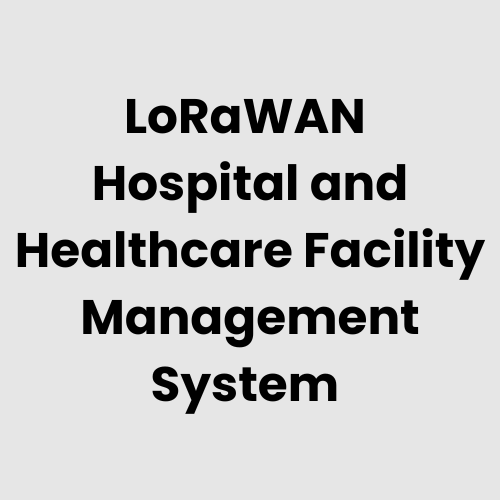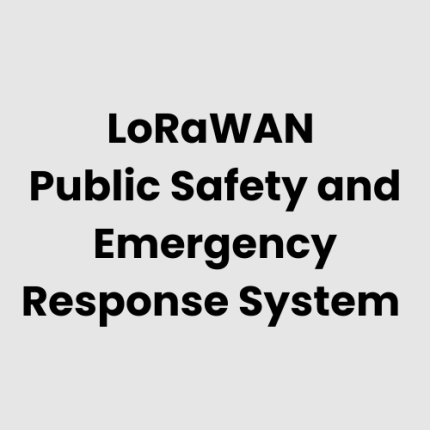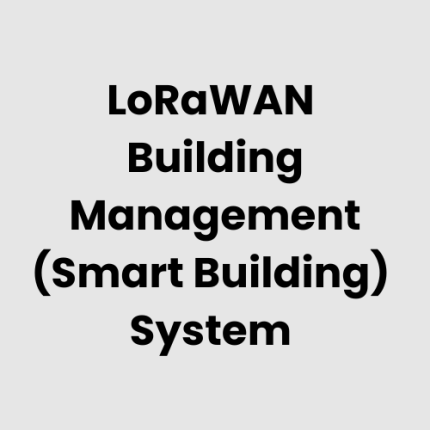Description
LoRaWAN Enabled Hospital and Healthcare Facility Management System
GAO Tek’s LoRaWAN Enabled Hospital and Healthcare Facility Management System provides a comprehensive solution to monitor, manage, and optimize operations within healthcare facilities. Using the power of IoT, this system improves patient safety, enhances operational efficiency, and ensures the smooth functioning of critical hospital assets, from medical equipment to environmental conditions.
Technical Architecture of LoRaWAN Enabled Hospital and Healthcare Facility Management System
The architecture of our LoRaWAN-enabled system integrates IoT devices with a robust network infrastructure to ensure seamless operation and real-time data management. The system is composed of several core components:
- IoT Sensors: Installed throughout the facility to monitor a variety of factors such as room temperature, humidity, air quality, medical equipment status, and patient movement. These sensors send data to LoRaWAN gateways over long-range wireless connections.
- LoRaWAN Gateways: Gateways serve as the communication bridge between the IoT sensors and the central data management system. These gateways are strategically placed to provide reliable coverage across the facility, ensuring all devices are connected.
- Edge Devices: Edge computing devices are used to process sensor data locally, providing real-time analytics and allowing for immediate decision-making, especially for critical conditions such as temperature anomalies or equipment malfunctions.
- Centralized Server/Cloud Platform: The data gathered by sensors is transmitted to a centralized server or cloud platform for further analysis, aggregation, and long-term storage. This enables predictive maintenance, performance tracking, and compliance monitoring.
- Management Dashboards: The platform includes customizable dashboards for hospital management and staff to view real-time data, receive alerts, and manage operations effectively. These dashboards integrate data from multiple sources to provide actionable insights.
List of Hardware of LoRaWAN Enabled Hospital and Healthcare Facility Management System
GAO Tek’s hardware components for the LoRaWAN-enabled hospital and healthcare facility management system are designed to ensure reliability and accuracy in demanding healthcare environments. The key hardware components include:
- IoT Sensors: Temperature, humidity, air quality, motion, and occupancy sensors to monitor the environment and patient movements.
- LoRaWAN Gateways: Gateways to receive and relay sensor data over a long-range wireless network.
- Edge Devices: Local processing units to handle real-time analytics and decision-making for urgent issues.
- Medical Equipment Monitoring Units: Devices that monitor the status and operational conditions of critical hospital equipment like ventilators, infusion pumps, and diagnostic machines.
- Server and Storage Units: Centralized systems to store and process large volumes of data, enabling data aggregation and long-term analysis.
- Management Dashboards: User interfaces for healthcare facility managers and staff to monitor and control the facility’s operational parameters.
- Power Supply Units: Uninterrupted power supply (UPS) systems to ensure the continuous operation of critical hardware.
- Network Routers: Secure and stable routers that manage the communication between devices and ensure data integrity across the network.
Physical Placement Considerations of LoRaWAN Enabled Hospital and Healthcare Facility Management System
The placement of hardware is crucial to ensure optimal performance of the system. Below are key physical placement considerations:
- Sensor Placement: Sensors should be strategically placed to cover key areas such as patient rooms, hallways, critical care units, operating rooms, and storage areas. Temperature, humidity, and motion sensors should be mounted in areas where they can provide the most relevant data, such as near equipment or in high-traffic patient areas.
- Gateway Placement: LoRaWAN gateways should be installed in central locations to maximize coverage across the entire facility, ensuring reliable communication with all connected sensors. The gateways should be positioned in areas with minimal obstructions to avoid signal interference.
- Edge Devices: Edge devices should be placed near critical systems or areas requiring real-time monitoring, such as intensive care units (ICUs) or surgical theaters. These devices process data locally to provide immediate responses.
- Server/Storage Placement: Servers and storage systems should be housed in secure, climate-controlled environments to ensure operational continuity and prevent downtime.
- User Interface Stations: Dashboards should be positioned in hospital command centers or management offices, allowing staff to monitor the system and respond quickly to alerts.
Hardware Architecture of LoRaWAN Enabled Hospital and Healthcare Facility Management System
The hardware architecture of the LoRaWAN-enabled healthcare management system integrates various IoT sensors, devices, and communication components for a robust and scalable solution:
- End Nodes (IoT Sensors): These devices are embedded throughout the hospital to monitor environmental conditions, patient movements, and equipment performance. They transmit data wirelessly to the LoRaWAN gateways.
- LoRaWAN Gateways: Serve as the communication hub, receiving sensor data and relaying it to edge devices or centralized systems for further processing and analysis.
- Edge Computing Devices: These devices provide localized processing for immediate action and reduce the burden on the central server by filtering and analyzing data on-site.
- Centralized Servers and Cloud Platform: Data collected by sensors is sent to these systems for long-term storage, advanced analytics, and reporting.
- Management Dashboards: Customizable interfaces for healthcare staff to access system data, receive alerts, and monitor facility operations in real-time.
Deployment Considerations of LoRaWAN Enabled Hospital and Healthcare Facility Management System
When deploying the LoRaWAN-enabled hospital and healthcare facility management system, several factors should be considered to ensure a successful implementation:
- Scalability: The system should be designed to easily scale as the healthcare facility grows, adding more sensors and devices as needed. GAO Tek’s solutions can be easily expanded to accommodate new buildings or departments.
- Integration with Existing Systems: The system must integrate with existing hospital management software, such as electronic health records (EHR) systems, for seamless data sharing and operational coordination.
- Network Coverage: Ensure proper placement of LoRaWAN gateways to achieve optimal network coverage across the entire healthcare facility, ensuring all sensors can reliably send data to the central platform.
- Data Security and Compliance: Healthcare facilities must adhere to strict privacy and security regulations, such as HIPAA. GAO Tek’s system ensures secure data transmission and storage, meeting all industry standards.
- Power Backup: Implementing backup power systems (e.g., UPS) ensures that the system remains operational in the event of power outages, which is critical for patient safety and equipment monitoring.
- User Training: Providing training for healthcare staff to properly use the system and manage alerts is key to ensuring smooth operations. GAO Tek offers comprehensive training programs for all users.
List of Relevant Industry Standards and Regulations
The LoRaWAN-enabled hospital and healthcare facility management system adheres to the following industry standards and regulations:
- HIPAA (Health Insurance Portability and Accountability Act)
- ISO 9001: Quality Management Systems
- ISO 27001: Information Security Management Systems
- IEC 60601: Medical Electrical Equipment
- CE Marking for European Compliance
- UL Certification for Safety Standards
- LoRaWAN Specification (by LoRa Alliance)
- FDA Regulations for Medical Devices
- IEC 62304: Software Life Cycle Processes for Medical Devices
- IEC 61508: Functional Safety for Electrical/Electronic/Programmable Electronic Systems
Local Server Version of LoRaWAN Enabled Hospital and Healthcare Facility Management System
GAO Tek offers a local server version of the LoRaWAN-enabled healthcare management system for facilities that require onsite data processing or prefer to keep sensitive data within their own infrastructure. This version includes:
- On-Premises Data Processing: Local servers handle critical data processing tasks, allowing real-time decision-making without relying on internet connectivity.
- Reduced Latency: With local processing, data can be acted upon immediately, providing faster responses for critical events like equipment failures or temperature fluctuations.
- Enhanced Data Security: Local storage ensures that sensitive data never leaves the facility, addressing privacy concerns for highly sensitive patient information.
Cloud Integration and Data Management
Cloud integration provides scalability, remote access, and advanced analytics for healthcare facilities using GAO Tek’s LoRaWAN system. Key benefits include:
- Real-Time Data Sync: The system synchronizes sensor data to the cloud in real-time, allowing for centralized monitoring and analysis from any location.
- Predictive Analytics: Leveraging cloud computing power, the system can run advanced predictive models to forecast maintenance needs, identify potential system failures, and optimize healthcare operations.
- Long-Term Data Storage: The cloud platform stores vast amounts of operational data, enabling trend analysis, historical reporting, and compliance audits.
- Remote Access: Authorized healthcare personnel can access data and receive alerts remotely, enabling better decision-making and faster responses to urgent situations.
GAO Case Studies of LoRaWAN Enabled Hospital and Healthcare Facility Management System
USA Case Studies
- New York City, NY
A major hospital in New York City implemented a LoRaWAN-enabled system to monitor environmental conditions in critical care units. The system ensures that temperature and humidity levels remain within optimal ranges for patient care, preventing equipment failure and improving patient safety. - Los Angeles, CA
A large medical center in Los Angeles utilized a LoRaWAN network to track medical equipment usage and performance. This allowed the facility to reduce downtime by performing predictive maintenance on devices like ventilators and MRI machines before they broke down, significantly improving operational efficiency. - Chicago, IL
A healthcare facility in Chicago integrated LoRaWAN sensors to monitor patient flow and room occupancy. The system automatically updates room availability in real-time, helping staff allocate resources efficiently and reducing patient wait times during peak hours. - Houston, TX
In Houston, a hospital used a LoRaWAN-enabled system to track oxygen tank levels across its facility. With real-time alerts and automatic reordering, the hospital ensured continuous supply without delays, preventing critical shortages and improving care delivery. - San Francisco, CA
A hospital in San Francisco implemented LoRaWAN sensors to monitor and control air quality and ventilation systems in their emergency department. The system enabled real-time adjustments to airflow, ensuring patient and staff safety by preventing the spread of airborne pathogens. - Miami, FL
In Miami, a healthcare provider deployed a LoRaWAN solution to manage temperature-sensitive medications in their pharmacy. The system automatically recorded temperature variations, sent alerts to staff when thresholds were exceeded, and ensured compliance with regulatory standards for drug storage. - Dallas, TX
A Dallas-based medical facility used LoRaWAN-enabled sensors for monitoring the performance of life-saving equipment in their intensive care unit. This solution allowed for real-time condition tracking and proactive maintenance, reducing unexpected failures and ensuring equipment availability when needed most. - Seattle, WA
A healthcare center in Seattle integrated LoRaWAN to manage medical waste in their facility. The system tracks the disposal process and provides data on the types and amounts of waste, ensuring compliance with environmental regulations and improving operational sustainability. - Boston, MA
A hospital in Boston deployed a LoRaWAN-based system for asset management, tracking surgical tools and medical supplies in real-time. The system significantly reduced loss, improved inventory accuracy, and ensured that critical items were always available when needed. - Atlanta, GA
In Atlanta, a healthcare facility used LoRaWAN sensors to monitor temperature and humidity levels across its server rooms. This allowed them to detect potential environmental risks before they became problems, ensuring that the facility’s critical IT infrastructure remained secure and operational. - Phoenix, AZ
A Phoenix-based healthcare provider leveraged LoRaWAN to manage the positioning and usage of medical carts within their facility. This system reduced time spent searching for equipment, increased staff productivity, and optimized resource allocation. - Washington, D.C.
A leading medical research facility in Washington, D.C. utilized LoRaWAN technology to track the health and performance of their laboratory equipment. Real-time monitoring reduced equipment failures and helped ensure the safety of both researchers and samples. - Denver, CO
A hospital in Denver implemented a LoRaWAN-powered system to track patient vitals and provide real-time health data to staff. This streamlined patient monitoring, enabling faster responses to changes in patient conditions and enhancing care quality. - Philadelphia, PA
In Philadelphia, a healthcare system used LoRaWAN-enabled IoT devices to monitor the status of their emergency power supply systems. This proactive monitoring allowed for early detection of faults, ensuring that backup generators were always ready to operate in the event of a power failure. - Detroit, MI
A hospital in Detroit integrated LoRaWAN technology into their facility management system, enabling real-time monitoring of building security and fire safety systems. With instant alerts and remote control capabilities, the system significantly improved response times to critical incidents.
Canada Case Studies
- Toronto, ON
In Toronto, a hospital leveraged GAO Tek’s LoRaWAN solution to monitor the operation of critical medical equipment across multiple departments. The system provided real-time condition reports and predictive maintenance alerts, improving both equipment uptime and patient safety. - Vancouver, BC
A healthcare facility in Vancouver implemented a LoRaWAN-based environmental control system to manage room conditions for patients with respiratory issues. The solution tracked air quality and adjusted ventilation to ensure optimal conditions for patient recovery, enhancing the overall healthcare experience.
Navigation Menu for LoRaWAN
- LoRaWAN Gateways
- LoRaWAN End Devices
- LoRaWAN – Cloud, Server, PC & Mobile Systems
- LoRaWAN Accessories
- LoRaWAN Resources
Navigation Menu for IoT
- LORAWAN
- ZIGBEE
- Wi-Fi HaLow
- Z-WAVE
- BLE & RFID
- NB-IOT
- CELLULAR IOT
- GPS IOT
- IOT SENSORS
- EDGE COMPUTING
- IOT SYSTEMS
Our products are in stock and can be shipped anywhere in the continental U.S. or Canada from our local warehouse. For any further information, please fill out this form or email us.
We are actively looking for partners who are like us located in the U.S. and Canada. For more information on partnering with GAO, please visit Partner with GAO Tek Inc. It lists various ways to partner with GAO, such as OEM Partnerships, Technology Integration, Distribution and Reselling Opportunities, Presenting at the Leading Event Tek Summit, Joint R&D Projects, Training and Consulting Services, Industry-Specific Collaborations, Research and Academic Partnerships.



